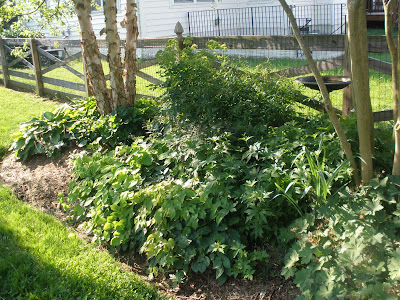I decided this year, in the spirit of a student I will never forget, to just go naked - the full monty. Instead of only showing carefully angled close-ups, or some of the cropped shots I posted last year after several plants died in a drought, once a month I'll show the garden exactly as it is. I go Full Monty around the first of every month. Enjoy!!
The Front Garden
A 'Pearle d'Azur' clematis climbs the columns in the front of the house while a chickadee nests in this house. Tradescantia, daylilies, phlox, and obedient plant grow at its base.
A dwarf spirea and coreopsis 'Sunshine Superman' grow between the steps and the clematis. The old birdbath was accidentally knocked over and now the spirea is full of flat glass marbles. Oy!
The clematis clambers over anything in its path, including my containers. A pink impatien peeks out from under clematis leaves.
A bunny lives in the dwarf abelia in the front yard. It's been dining al fresco on my toad lilies. 'Endless Summer' hydrangea grow under the window. The abelia's leaves will turn pink, cream, and green as it gets hotter. They are still spring green right now.
A long row of trailing lavender lantana grows alongside the front walkway. Lantana laughs off heat, drought, and utter neglect. Plus, the pollinators love it!
The Yuck Side
The rainbow leucothoe (left) in front of the lilacs looks like a space alien.
The Big Daddy rain barrel in the back corner can hold 156 gallons.
Meet Fred, the world's biggest bleeding heart. That is only ONE plant!!
The Dry Side
Salvia 'Plumerosa' (I think!) is a very early bloomer that sprawls and flops while the other plants are still sprouting. It's quite a hog! After its first flush of blooms, I cut it back hard to keep it it line.
I love its fluffy purple flowers.
The dogs have been going on safari in this part of the garden! Ugh! The milkweed and perennial snapdragons have been trampled quite a bit. The snapdragons need to start biting back!!
Perennial snapdragons are the host for the little buckeye butterfly. Last fall, they were covered with caterpillars.
Veronica spicata 'Ericka' - New foliage is red before slowly turning green.
The trumpet creeper is filling out and should be covered with orange flowers within the next few weeks. I keep it pruned into submission or it would take over. It's constantly waging war with my garden and has invaded my neighbors grass. Oops!
The Dog Run Garden
It's officially summer when we put out the hammock. Even the dogs like to lay in it.
The wine cups are some of the earliest bloomers. The enormous mound behind them is seed grown rudbeckia triloba that I forgot I had sown until they started growing and squeezed out the more mild mannered 'Goldsturm'. Holy cow! They are about 4 1/2 feet tall and haven't even bloomed yet!
I just added some variegated sedum to the garden. The burgundy knautia bloom all summer.
The Stella d'Oro's have just started to open.
This picture is taken from inside the dog run, which is almost invisible at this point. Daylilies, 'Chocolate' eupatorium, and a huge clump of various monardas grow well here. The daylilies are being shaded by the monster rudbeckia. A wren has taken up residence in the red bird house.
Lucy hangs out in the dog run near the cup plant, a southeastern native. It's leaves form a cup where they meet the stem. This will put up three foot stalks of yellow daisy-like flowers with seeds that are loved by the birds. I've seen birds drink from the water caught in the little "cups". Lucy is a beagle/basset/golden retriever mix that was nearly put to sleep at a rural pound before being rescued by the no-kill shelter I volunteer for.
The Back Garden
The scabiosa and pink knautia have already started blooming. White dianthus is still blooming in the corner. This bed is full of asters, agastache, coneflowers, helianthus, geraniums, sedum, dalea, and ornamental oregano.
The clematis along the back fence is still blooming. The pink clematis blooms first followed by the lavender.
The Chester Thornless blackberries are devoured by the birds every summer.
Spigellia marilandica, a native wildflower, is thriving in the moist shade near the blackberries. I've also heard them called Lipstick plant.They attract hummingbirds.
Spigelia grows between pink Persian Cornflowers and white balloon flowers.
Tradescantia near the crepe myrtles. Blackberries grow on the other side of the crepe myrtle.
I think the asters suffocating under the helianthus and bigroot geranium need a new home in another spot in the garden!
The River Birch Garden
The epimediums are so happy in the dry shade here, they're muscling out several other plants.
The beautiful variegated brunnera and most of the tiarella died in the drought last year. I've filled their spot with a chrysoganum 'Quinn's Gold'. It's hard to see in this picture.
The Dogwood Garden
Yellow helianthus are already five feet tall! They weren't this big last year! I took three small shrubs out of this bed to give the interior plants more sun and it's really paying off.
Another sweetspire, geraniums, yarrow, coneflowers, lilies, and more fill this bed.
I wonder how long the columbine will keep going!!
The Rose of Sharon Garden
For my birthday I bought a rock! Diamonds don't impress me much but I'm a sucker for an awesome rock.
The pink clematis and 'Sceptre d'Isle' rose will bloom for several more weeks. Geraniums and phlox grow between the rose and the patio. The Rose of Sharon is covered in tiny buds.
White heart leafed asters and blue plumbago grow in the dry shade under the Rose of Sharon.
















































